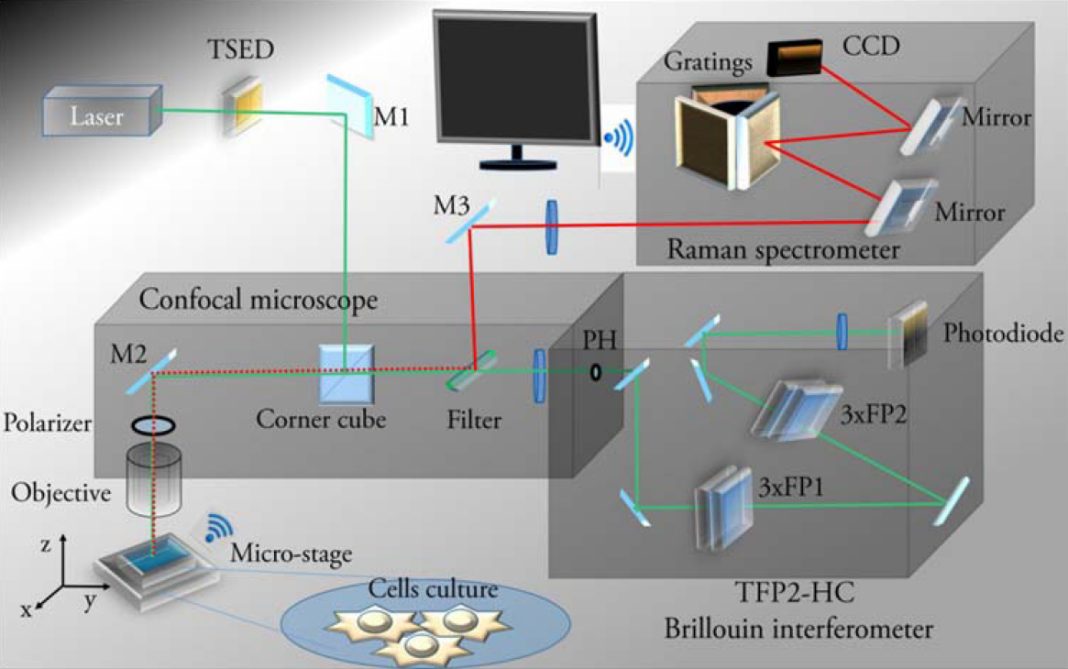Noninvasive techniques are typically thought of in reference to the entire patient or large organs, yet what if we were to think about the value of noninvasive techniques at the cellular level. An experimental technique that can noninvasively probe in situ the elastic and the biochemical properties of cells and tissues would be a strategic diagnostic tool. Just like mechanical properties and chemical compositions of materials are of fundamental importance in buildings, the cells that build up every living organism have different properties and shapes depending on their function and state. Now, researchers at the University of Perugia, Italy have just released findings about the use of a new spectrometer capable of analyzing living cells in situ, in a noninvasive manner, and with submicrometric spatial resolution.
Findings from the study were published recently in Light: Science & Application in an article entitled “Non-Contact Mechanical and Chemical Analysis of Single Living Cells by Micro-Spectroscopic Techniques.”
“Cellular complexity prevents any single technique or experiment from revealing the details of the structure and active processes, which can span several decades in length and time,” the authors wrote. “A multidisciplinary approach and the combined use of complementary techniques is an essential requirement to provide novel insights in this field. Bio-photonics and light-based technologies working in a contact-less configuration have been increasingly utilized to gain comprehension of fundamental biological issues. Thanks to recent improvements, confocal laser scanning microscopy, immunohistochemistry and fluorescence techniques allow for the acquisition of functional images that are pivotal for the characterization of the processes and distribution of molecular species in cells and overcome the diffraction limit.”
In recent years, optics and photonics, and in particular the microspectroscopic techniques, have demonstrated their effectiveness for the materials analysis. In the current study, the researchers found that their new optical system, in fact, acquires the Brillouin and Raman spectra simultaneously, while exploiting the interaction between light and matter. Moreover, the microspectroscopic device can provide a contactless mechanical and chemical map of the system under investigation.
The research team, a collaboration of physicists and biotechnologists, took their methodology a step further by extending this approach to the analysis of single living cells, proving, in particular, the ability of the technique to monitor mechanical modulation due to subcellular protein structures.
“The unprecedented statistical accuracy of the data combined with the high frequency resolution and the high contrast of the recently built experimental setup permits the study of single living cells immersed in their buffer solution by contactless measurements,” the authors remarked. “The Brillouin signal is deconvoluted in the buffer and the cell components, thereby revealing the mechanical heterogeneity inside the cell. In particular, a 20% increase is observed in the elastic modulus passing from the plasmatic membrane to the nucleus as distinguished by comparison with the Raman spectroscopic marker.”
The research team also noted that since previous studies have shown that cells show a significant softening upon oncogene expression, this property can explain the invasive potential observed in tumor cells—their increased deformability helps them spreading through the narrow spaces of the extracellular matrix, favoring the future development of metastasis. Moreover, this highlights how mechanical properties of cells can be a new biomarker for pathologies and how the proposed technique can become a potential diagnostic tool, even in tumors.
“In a proof-of-principle experiment, the ability of this spectroscopic technique to characterize subcellular compartments and distinguish cell status was successfully tested” the authors concluded. “The results strongly support the future application of this technique for fundamental issues in the biomedical field.”



